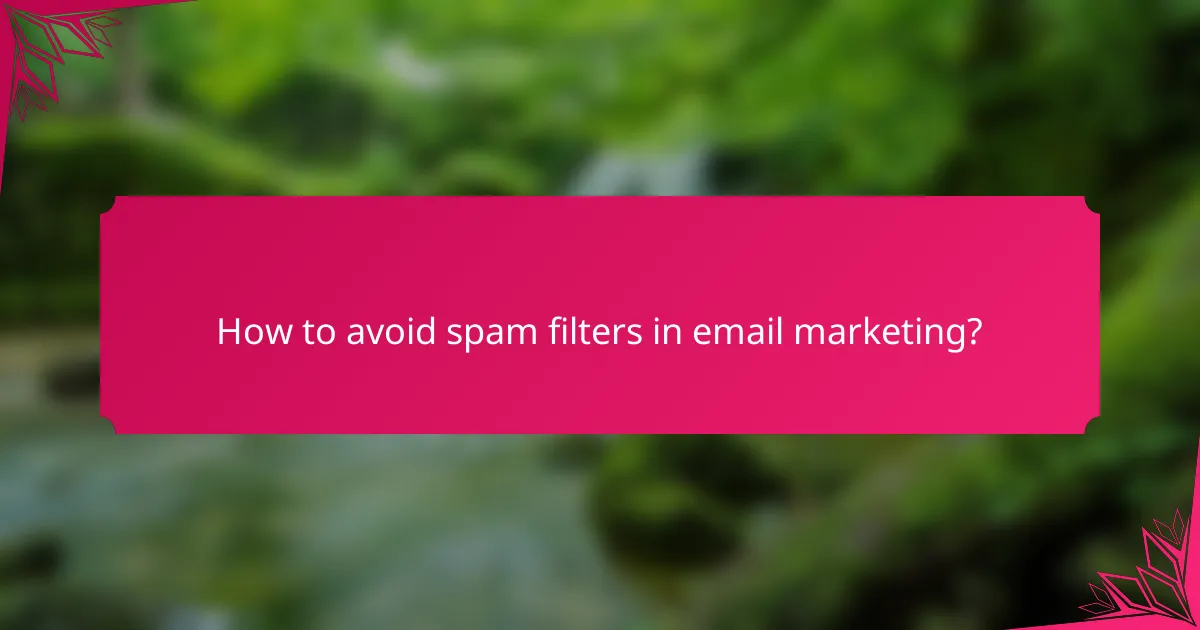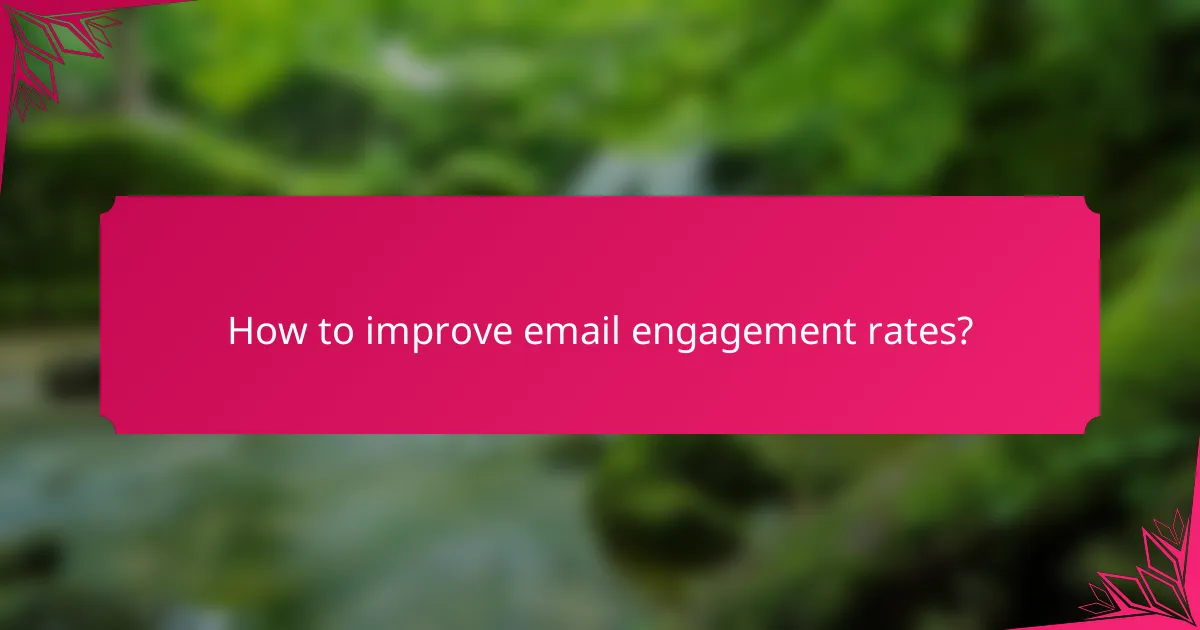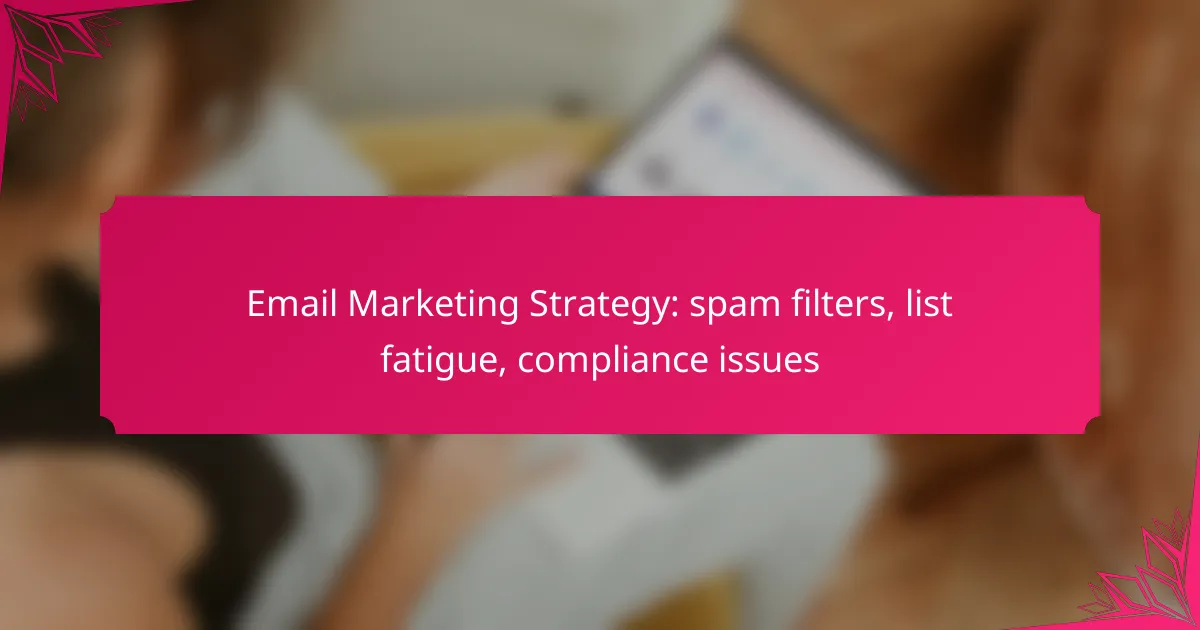Email marketing is a powerful tool, but it comes with challenges such as navigating spam filters, combating list fatigue, and ensuring compliance with regulations. To enhance deliverability and engagement, marketers must prioritize high-quality content and adopt best practices like double opt-in methods. Additionally, addressing list fatigue requires a keen understanding of subscriber preferences and behaviors to maintain interest and interaction.

How to avoid spam filters in email marketing?
To avoid spam filters in email marketing, focus on building a reputable sender profile and maintaining high-quality content. Implementing best practices such as double opt-in methods and optimizing subject lines can significantly enhance deliverability rates.
Use double opt-in methods
Double opt-in methods require subscribers to confirm their email address after signing up, ensuring that only interested individuals join your list. This process reduces the likelihood of fake or mistyped addresses, which can trigger spam filters.
Implementing double opt-in can also improve engagement rates, as subscribers who confirm their interest are more likely to interact with your emails. Consider using a clear confirmation message and a user-friendly process to enhance the experience.
Optimize subject lines
Optimizing subject lines is crucial for avoiding spam filters and improving open rates. Use clear, concise language and avoid excessive punctuation or all caps, which can raise red flags for spam filters.
Incorporate relevant keywords that reflect the email content, and consider personalizing subject lines to increase engagement. A/B testing different subject lines can help identify what resonates best with your audience.
Maintain a clean email list
Regularly maintaining a clean email list helps prevent spam complaints and improves deliverability. Remove inactive subscribers and bounced emails to keep your list healthy and engaged.
Consider using list segmentation to target specific groups based on their behavior and preferences. This approach not only enhances engagement but also reduces the risk of being flagged as spam.
Monitor sender reputation
Monitoring your sender reputation is vital for successful email marketing. Factors such as bounce rates, spam complaints, and engagement metrics influence your reputation with email service providers.
Use tools to track your sender score and address any issues promptly. Maintaining a good reputation can significantly improve your chances of bypassing spam filters and reaching your audience effectively.
Utilize authentication protocols
Utilizing authentication protocols like SPF, DKIM, and DMARC helps verify your identity as a sender and enhances email deliverability. These protocols protect your emails from being spoofed and improve trust with email providers.
Implementing these protocols may require some technical setup, but the benefits of increased deliverability and reduced spam filtering make it worthwhile. Regularly check your authentication status to ensure compliance and effectiveness.

What causes list fatigue in email marketing?
List fatigue in email marketing occurs when subscribers lose interest in receiving emails, leading to decreased engagement and higher unsubscribe rates. This can be attributed to several factors, including the frequency of emails, the relevance of content, and the level of personalization in communications.
High email frequency
Sending emails too frequently can overwhelm subscribers, causing them to disengage or unsubscribe. A good practice is to limit email frequency to a few times per week, depending on your audience’s preferences and the nature of your content.
Monitor engagement metrics such as open rates and click-through rates to gauge whether your email frequency is appropriate. If you notice a decline in these metrics, consider reducing the number of emails sent.
Poor content relevance
Content that does not resonate with subscribers can lead to list fatigue. Ensure that your emails provide value by aligning with the interests and needs of your audience. Segmenting your email list based on subscriber behavior or preferences can enhance content relevance.
Regularly review and update your subscriber profiles to maintain relevance. Use surveys or feedback forms to gather insights on what content your audience finds most appealing.
Lack of personalization
Generic emails that lack personalization can make subscribers feel disconnected from your brand. Incorporate personalized elements such as the subscriber’s name, tailored recommendations, or location-based offers to foster a stronger connection.
Utilize data analytics to understand subscriber behavior and preferences, allowing you to create targeted campaigns. Personalization can significantly improve engagement rates and reduce the likelihood of list fatigue.

How to improve email engagement rates?
Improving email engagement rates involves strategies that capture attention and encourage interaction. Focus on understanding your audience, testing different approaches, and incorporating engaging elements into your emails.
Segment your audience
Segmenting your audience allows for targeted messaging that resonates with specific groups. By dividing your email list based on demographics, interests, or past behaviors, you can tailor content to meet the unique needs of each segment.
For example, a retail brand might create segments for frequent buyers, seasonal shoppers, and first-time visitors. This enables personalized promotions that are more likely to convert, leading to higher engagement rates.
Use A/B testing
A/B testing, or split testing, involves sending two variations of an email to different segments of your audience to determine which performs better. This method helps identify what elements—such as subject lines, images, or call-to-action buttons—drive higher engagement.
Start by testing one variable at a time and analyze the results to make informed decisions. Aim for a statistically significant sample size to ensure your findings are reliable, and apply the insights to future campaigns.
Incorporate interactive content
Interactive content, such as polls, quizzes, or videos, can significantly enhance email engagement. By inviting recipients to participate, you create a more dynamic experience that encourages them to interact with your brand.
Consider including a short quiz related to your products or services, or a poll asking for feedback on a recent purchase. This not only boosts engagement but also provides valuable insights into customer preferences.

What are the compliance issues in email marketing?
Compliance issues in email marketing primarily revolve around adhering to regulations that protect consumer privacy and ensure transparent communication. Marketers must navigate laws like GDPR and the CAN-SPAM Act to avoid penalties and maintain trust with their audience.
Understanding GDPR regulations
The General Data Protection Regulation (GDPR) is a comprehensive privacy law in the European Union that governs how personal data is collected, processed, and stored. Email marketers must obtain explicit consent from individuals before sending marketing communications and provide clear information about how their data will be used.
Non-compliance can lead to significant fines, often reaching up to 4% of a company’s global annual revenue. To comply, businesses should implement transparent data collection practices and allow users to easily access and manage their preferences.
CAN-SPAM Act requirements
The CAN-SPAM Act sets rules for commercial email in the United States, requiring marketers to include specific elements in their emails. These include a clear identification of the message as an advertisement, the sender’s physical address, and a straightforward way for recipients to opt-out of future emails.
Failure to comply with the CAN-SPAM Act can result in fines of up to $43,000 per violation. Marketers should regularly review their email practices to ensure they meet these legal requirements and maintain a good reputation.
Managing unsubscribe requests
Effectively managing unsubscribe requests is crucial for compliance and maintaining a positive relationship with subscribers. Under both GDPR and the CAN-SPAM Act, marketers must honor unsubscribe requests promptly, typically within a few business days.
To streamline this process, include a clear and easy-to-find unsubscribe link in every email. Regularly cleaning your email list can also help reduce the number of unsubscribe requests by ensuring that you are only sending content to engaged recipients.

How to choose an email marketing platform?
Choosing an email marketing platform involves evaluating features, pricing, and customer support to find the best fit for your business needs. A well-selected platform can enhance your email campaigns, improve deliverability, and ensure compliance with regulations.
Evaluate features and integrations
When assessing email marketing platforms, prioritize features that align with your goals, such as automation, segmentation, and analytics. Look for integrations with your existing tools, like CRM systems or e-commerce platforms, to streamline your workflow.
Common features to consider include A/B testing, customizable templates, and reporting capabilities. Ensure the platform can handle your list size and offers tools to manage spam filters effectively.
Consider pricing models
Email marketing platforms typically offer various pricing models, including pay-as-you-go, monthly subscriptions, or tiered pricing based on the number of subscribers. Evaluate your budget and expected growth to choose a model that provides value without overspending.
Some platforms may offer free tiers with limited features, which can be a good starting point for small businesses. Be cautious of hidden fees for additional features or exceeding subscriber limits.
Assess customer support options
Reliable customer support is crucial when choosing an email marketing platform. Look for providers that offer multiple support channels, such as live chat, email, and phone support, to ensure assistance is readily available when needed.
Check for user reviews regarding response times and the quality of support. A platform with comprehensive documentation and tutorials can also help you troubleshoot issues independently, saving time and frustration.

What are the best practices for email list management?
Effective email list management involves maintaining a clean, engaged list while ensuring compliance with regulations. By following best practices, marketers can enhance deliverability, reduce spam complaints, and improve overall campaign performance.
Regularly clean your email list
Regularly cleaning your email list is crucial for maintaining high engagement rates and avoiding spam filters. This process involves removing inactive subscribers, correcting invalid email addresses, and ensuring compliance with regulations like GDPR or CAN-SPAM.
To effectively clean your list, consider implementing a schedule, such as quarterly reviews. During these reviews, identify subscribers who haven’t engaged with your emails in the past six months and consider sending a re-engagement campaign before removing them.
Additionally, use tools that can automatically detect and remove invalid email addresses. This proactive approach helps maintain a healthy list and can significantly improve your email deliverability rates.
